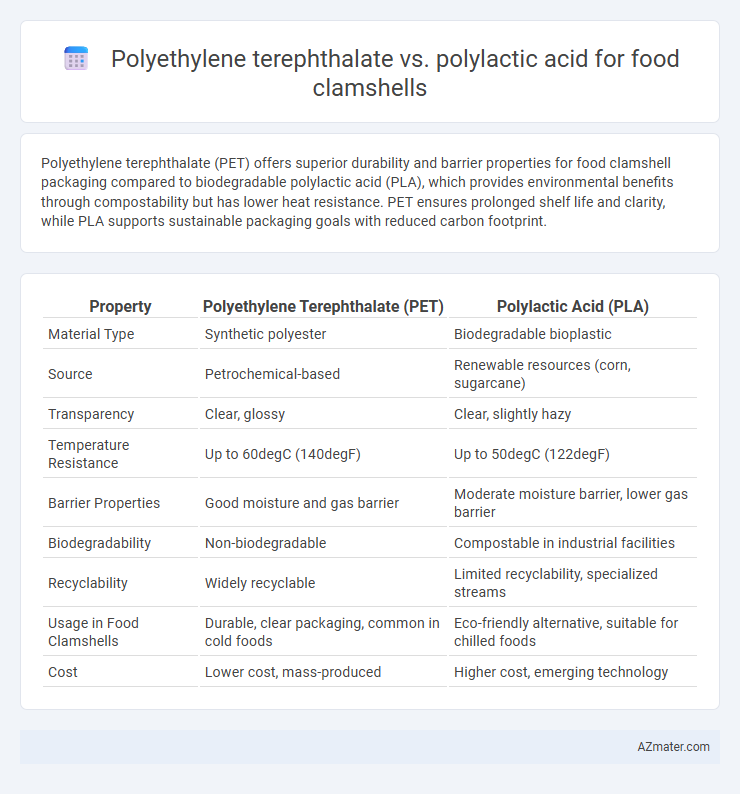Polyethylene terephthalate (PET) offers superior durability and barrier properties for food clamshell packaging compared to biodegradable polylactic acid (PLA), which provides environmental benefits through compostability but has lower heat resistance. PET ensures prolonged shelf life and clarity, while PLA supports sustainable packaging goals with reduced carbon footprint.
Table of Comparison
| Property | Polyethylene Terephthalate (PET) | Polylactic Acid (PLA) |
|---|---|---|
| Material Type | Synthetic polyester | Biodegradable bioplastic |
| Source | Petrochemical-based | Renewable resources (corn, sugarcane) |
| Transparency | Clear, glossy | Clear, slightly hazy |
| Temperature Resistance | Up to 60degC (140degF) | Up to 50degC (122degF) |
| Barrier Properties | Good moisture and gas barrier | Moderate moisture barrier, lower gas barrier |
| Biodegradability | Non-biodegradable | Compostable in industrial facilities |
| Recyclability | Widely recyclable | Limited recyclability, specialized streams |
| Usage in Food Clamshells | Durable, clear packaging, common in cold foods | Eco-friendly alternative, suitable for chilled foods |
| Cost | Lower cost, mass-produced | Higher cost, emerging technology |
Introduction to Food Clamshell Packaging
Food clamshell packaging is designed to provide secure, lightweight containers primarily used for transporting and displaying fresh food products. Polyethylene terephthalate (PET) offers excellent clarity, durability, and moisture resistance, making it a preferred choice for preserving freshness and product visibility. Polylactic acid (PLA), derived from renewable resources, provides a biodegradable alternative, promoting environmental sustainability while maintaining sufficient structural integrity for food protection.
Overview of Polyethylene Terephthalate (PET)
Polyethylene terephthalate (PET) is a widely used thermoplastic polymer known for its strength, clarity, and barrier properties, making it ideal for food clamshell packaging. PET offers excellent resistance to moisture and oxygen, ensuring extended shelf life and freshness of food products. Its recyclability and ability to be thermoformed into durable, lightweight containers contribute significantly to sustainable packaging solutions in the food industry.
Overview of Polylactic Acid (PLA)
Polylactic acid (PLA) is a biodegradable thermoplastic derived from renewable resources such as corn starch or sugarcane, making it an eco-friendly alternative to conventional plastics like polyethylene terephthalate (PET). PLA exhibits excellent clarity and is compostable under industrial conditions, which enhances its appeal for sustainable food clamshell packaging. However, PLA has lower heat resistance and mechanical strength compared to PET, limiting its use in applications requiring high durability or thermal stability.
Material Properties: PET vs PLA
Polyethylene terephthalate (PET) exhibits superior tensile strength, chemical resistance, and thermal stability compared to polylactic acid (PLA), making it ideal for durable and heat-resistant food clamshell packaging. PLA, derived from renewable resources, offers excellent biodegradability and compostability but has lower impact resistance and a melting point typically below 180degC, limiting its use in high-temperature applications. The choice between PET and PLA hinges on balancing material performance requirements, sustainability goals, and end-of-life disposal methods for food clamshell products.
Food Safety and Regulatory Compliance
Polyethylene terephthalate (PET) is widely recognized for its strong barrier properties, chemical resistance, and FDA approval for direct food contact, making it a preferred choice for food clamshell packaging regarding food safety and regulatory compliance. Polylactic acid (PLA), derived from renewable resources, offers compostability and meets FDA standards for food contact but may have lower heat resistance and barrier performance, potentially affecting food preservation. Both materials require adherence to specific regulatory guidelines, but PET's robust compliance history often gives it an advantage in stringent food safety applications.
Environmental Impact: Biodegradability and Recycling
Polyethylene terephthalate (PET) is widely recycled through established recycling systems but is non-biodegradable, contributing to long-term plastic pollution. Polylactic acid (PLA) offers biodegradability under industrial composting conditions, reducing landfill persistence, though its recycling infrastructure is limited and often incompatible with PET recycling streams. The environmental impact favors PLA for end-of-life biodegradability, while PET excels in circular material recovery through high-speed recycling processes.
Cost and Availability Analysis
Polyethylene terephthalate (PET) offers superior cost efficiency due to its widespread production and well-established supply chains, making it the preferred choice for food clamshell packaging in large-volume applications. In contrast, polylactic acid (PLA), derived from renewable resources like corn starch, generally incurs higher costs and faces limited availability because of less developed manufacturing infrastructure and smaller scale production. The economic advantage of PET combined with its consistent availability supports its dominance in the packaging industry, while PLA's sustainability benefits are often offset by its premium price and supply constraints.
Performance in Food Preservation
Polyethylene terephthalate (PET) offers superior barrier properties against moisture and oxygen infiltration, significantly extending the shelf life of perishable foods compared to polylactic acid (PLA). PET's high mechanical strength and thermal resistance maintain clamshell integrity under various storage conditions, preventing contamination and physical damage. While PLA provides biodegradability and compostability, its relatively lower barrier performance and heat tolerance may compromise food preservation for extended storage or high-moisture products.
End-of-Life Disposal Options
Polyethylene terephthalate (PET) food clamshells offer high recyclability through established municipal recycling programs, contributing to a circular economy when properly processed. Polylactic acid (PLA) clamshells provide industrial compostability under controlled conditions, enabling biodegradation into non-toxic components but requiring specialized composting facilities. Both materials present distinct end-of-life disposal pathways, with PET favoring mechanical recycling and PLA emphasizing composting for sustainable food packaging waste management.
Choosing the Best Material for Food Clamshell Packaging
Polyethylene terephthalate (PET) offers superior clarity, mechanical strength, and gas barrier properties, making it ideal for preserving food freshness and ensuring product visibility in clamshell packaging. Polylactic acid (PLA), derived from renewable resources, provides biodegradability and compostability, appealing to eco-conscious consumers despite its lower heat resistance and mechanical durability compared to PET. Selecting the best material depends on balancing sustainability goals with performance requirements such as durability, transparency, and shelf life in food clamshell applications.

Infographic: Polyethylene terephthalate vs Polylactic acid for Food Clamshell
 azmater.com
azmater.com